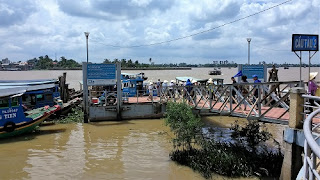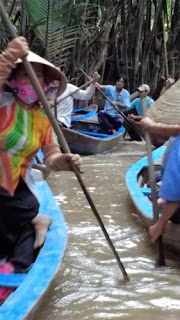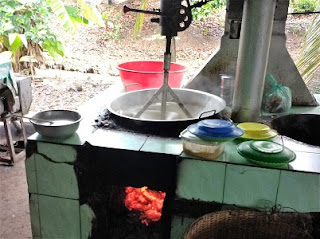Do you know the song “The Farmer in
the Dell”? Cute song. Repetitive, additive, fun for kids. But there
is a lot of taking in the song. The farmer takes a wife. The wife
takes a child. The child takes a nurse and so on all the way down to
the cheese. The cheese, in its own selfless way, takes nothing. It
stands alone. And I never knew exactly what it means to say the
cheese stands alone. But it's beside the point. The song is all about
taking.
And in that vein, we recently took. We
took a trip, a tour, if you will, of the Mekong Delta. The Mekong
River is one of the longest rivers in Asia. It flows through seven
countries: Tibet, China, Thailand, Myanmar, Laos, Cambodia, and
Vietnam. Here in Vietnam is where it flows to the sea. But as it
nears the ocean, the river spreads out into an alluvial plain.
An alluvial plain is a flatland where
the river forks into many fingers that flow to the sea, what we call
a delta. That's because the capital form of the Greek letter delta is
shaped like a triangle, and that is the shape that the fingers of the
river make. But the other great thing about an alluvial plain is the
soil. The river, after traveling so far, has picked up many wonderful
minerals and nutrients. And as it spreads out over the flatland and
splits into fingers, it tends to deposit many of these. So alluvial
plains are frequently great lands for growing food.
The Mekong River Delta is no exception.
Farmers in the region grow rice, lots of rice. But they also grow
many wonderful tropical fruits. We got to enjoy some firsthand. But
I'll get to that.
First we boarded a bus in Ho Chi Minh
City for the hour and a half ride down to the Mekong River. Our first
stop was the Chùa Vĩnh Tráng.
 |
| I got pictures of this from all (actually three) sides, but I like this one the best. |
Vĩnh Tráng means infinity. While chùa
means temple, and this is an incredibly unusual Buddhist Temple. Why
unusual? Well, the original temple was destroyed by termites. So a
new temple was reconstructed in 1907. This was during the time that
Vietnam was a French colony. So the temple has a fusion of design
elements. The pitched roofs are similar to Chinese pagodas. The
interiors are very Cambodian in style. And the exterior facades
resemble a large French villa. A very unusual mix.
 |
| It doesn't exactly scream France, but it does have elements. |
The garden outside the temple includes
jasmine trees and their fragrance was strong and delightful. The
gigantic statues of Buddha, standing, sitting, and sleeping were
white, gleaming, and bold.
 |
| The clouds made a nice arch |
 |
| That is one happy guy! |
 |
| Not the most comfortable mattress, but he is beyond material concerns. |
The interior was lavishly decorated,
with not an inch of barren wall or ceiling left alone.
 |
| I love the mix of the modern and traditional elements here. |
 |
| I wonder if we are allowed to beat this drum. |
 |
| Apparently these are the rules. It's okay, I wasn't that hungry. |
From the Chùa Vĩnh Tráng we rode in
the bus to the boat dock.
 |
| We visited on a Sunday which is a popular day for the Vietnamese to go to the delta as well. |
Here we got tickets for a motorboat to
take us across the wide Mekong River. The boat was long and had a
very loud engine, so we missed much of what our tour guide, Nia, was
telling us while we crossed the river. But we learned plenty more
when we reached the other side.
 |
| Welcome to Fantasy (well, Unicorn) Island |
We landed on Unicorn Island. But in
Southeast Asia, a unicorn is not a horse with a horn on its head.
Their version of a unicorn is a creature whose lower body is that of
a lion, upper body and head are those of a dragon, and who has an arm
with a hand over a sphere. You frequently see statues of such
creatures at Buddhist and Hindu temples in the area. (Though we
didn't see one at Chùa Vĩnh Tráng.) We also didn't see any of
those mythical creatures on the island, so I'm not sure how it got
its name. Maybe they're nocturnal and we just missed them due to
being there in the day.
First we visited a stop where we got to
taste the honey collected on the island. About half of the island is
dedicated to growing longan trees. A longan is a fruit with a thin
peel and then a soft translucent white fruit inside. In the middle of
the fruit is a large dark seed (that floats, as we would later see
during our rowboat ride.) It is related to a lychee, if you know what
that fruit is.
On Unicorn Island, they raise bees that
get their nectar from the longan tree flower. The bees are much
smaller than the honeybees we are used to in the United States,
adapted to the tiny flowers of the longan tree.
 |
| Yeah, my wife touched that. Crazy brave (or just crazy.) |
And the honey has a distinct flavor. I
mean, it tastes and looks enough like honey that you would know it
was honey. But it is a bit less viscous than the honey we are used to
and has a flavor that differs from clover honey or wildflower honey
in America. We got to see the bees in a hive. And they wanted someone
from our group to touch the honeycomb (covered in bees) and taste the
honey directly from the comb. First they asked Carver to do it and he
was not going near that. Luckily, Alrica volunteered to “take one
for the team”. She touched the honeycomb, was ignored by the bees,
tasted the honey, and declared it “very good.”
We went from that stop to another area
where we got to taste five fruits grown on the island. We were
serenaded by locals while we ate. They sang songs in Vietnamese,
though they closed with “If You're Happy and You Know It Clap Your
Hands” in English.
The five fruits, which we were told to
eat in order, were: Pineapple, Mango (which was an interesting
variety that was both sweet and sour), White Dragonfruit, Watermelon
(and I admit, I did not partake in that one myself being less than a
fan of all things melon), and Longan. We had tried all but the longan
before. However, we figured out how to peel and eat the longan,
because a fruit we have tried is rambutan. They're similar, not in
appearance, but in form.
From there we walked to a dock, but not
on the Mekong River itself. Throughout Unicorn Island, there are
streams/canals that flow. They are natural streams, but people have
dug them out to make them wider, so they sometimes call them canals.
Here we boarded rowboats. They were thin like canoes and kayaks, but
longer. We didn't have to do the rowing, we had local boatmen and
boatwomen who took us about three kilometers.
 |
| Ready to row! |
It was a beautiful view of the trees
and the banks. In the middle it began to rain, lightly at first, but
then with more vigor. No problem. Our boat owners had the pitched
conical hats that natives where, one for each of us. And they had
plastic sheeting to put around ourselves to keep dry-ish.
 |
| Traffic jam! |
 |
| I'm not real down with selfies. Apparently the smiling idea is beyond me. |
The dock where we left the rowboats was
where the stream met the main river again. Here we re-boarded our
motorboat. It took us to another area in the delta, one that our
guide referred to colloquially as “Coconut Town”. In this area,
not only do they grow coconut palms, but they use every part of the
coconut for everything. The buildings are made of coconut palm wood.
The roof of said buildings is made from dried coconut palm leaves.
Utensils for eating and cooking are made of the wood. Cups are made
from cast off husks of coconuts. Animal feed comes from the edible
parts of the coconut not consumed by humans. Fertilizer is made from
the leavings when the coconut milk and meat have been collected. The
milk of young coconuts, which is sweet, is used as a beverage (which
we got to enjoy on the boat trip to Coconut Town.) The milk of fully
ripe coconuts, which is sour, is used for cooking. The coconut oil is
used as a cosmetic. And the coconut meat, naturally, is used to make
candy.
Candy? Yes, candy. We visited a coconut
candy factory. There was a machine to remove the husks from the
coconut. Then another machine shredded the coconut meat. This was
placed into a large press to squeeze out the sweet sweet milk that is
inside. (The remaining milkless pulp of the meat is fed to animals.)
This sweet milk is cooked and stirred until it becomes thick. And
then it is made into a chewy sticky candy, almost like caramels, but
not caramel flavored.
 |
| They used to do this by hand. Happy technology! |
 |
| There it is, ready to be cut and wrapped. |
The candies were combined with other
flavors as well, so you could get coconut candy with ginger flavor,
or durian, or chocolate, or peanut, or pandan leaf, or just plain
coconut.
Also at the candy factory, we had the
opportunity to try snake wine. Snake wine is bizarre. There is a huge
jar filled with dead snakes, geckos, scorpions, and ravens.
 |
| Yes, snake wine really is snake and much more. They should call it snake, et. al. wine. |
Nia told us the snakes are skinned, but
their venom is not removed because it is a necessary ingredient of
the wine. I'm not sure where the original source of liquid or yeast
is, but this jar definitely ferments. It smelled like wine.
Nia asked for volunteers to try the
snake wine. Both Alrica and I tried a sip. It was strong, clear, and
had a flavor I would be hard pressed to describe. It wasn't bad and
certainly clears out your sinuses. Nia told us it is about 40%
alcohol. And he insists that you can drink as much of it as you want
and you won't get drunk, because it is medicinal. I can believe that
the Vietnamese use it medicinally, but I didn't quite accept the
“drink as much as you want and never get drunk” claim. Not that I
did an experiment to find out if Nia was right or not, but I am
skeptical.
 |
| We're either sweaty, rain-soaked, and tired or else the snake wine is kicking in. You make the call. |
From Coconut Town we got on our boat
again and rode to our last stop: a restaurant with a dock right on
the river. Here we enjoyed a sumptuous lunch. We had spring rolls
made from Elephant Ear Fish, and there was plenty of meat left on the
fish to enjoy after you had eaten the spring rolls.
 |
| Apparently the uncooked fish looks like an elephant's ear. |
In addition we had catfish in a thick
and tasty gravy, a vegetable that looked and tasted a lot like green
beans or string beans (and maybe it was exactly that), and a
Vietnamese omelet with spring onion, garlic, soy sauce, sugar, and
fish sauce. (Fish sauce is a big thing in Vietnam. Lots of cooking is
done with it. It's made from tiny fish, like anchovies, that have
been boiled for a long long time.)
 |
| Really? He's making us look at pictures of his lunch? |
Dessert was watermelon. Again, I
passed. But I had plenty of elephant ear, so I wasn't starving.
 |
| When all three generations have a good time, it's a win-win-win. |
There was no dairy in the meal. Dairy
generally isn't so common in Southeast Asia, though you see more of
it in Vietnam because of the French influence. But we didn't see any
dairy, not even a morsel of cheese, during our time with the farmers
in the delta.
That's probably because the cheese was
busy standing alone.
No comments:
Post a Comment